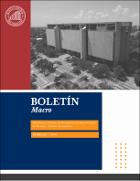| dc.creator | Rojas, Bernardo Darío |
| dc.creator | Rodríguez, Natalia |
| dc.creator | Patiño, María José |
| dc.date.accessioned | 2020-12-28T19:23:08Z |
| dc.date.available | 2020-12-28T19:23:08Z |
| dc.date.created | 2006-02-01 |
| dc.date.issued | 2006-02-01 |
| dc.identifier.citation | Baqueiro Cárdenas, A., Díaz de León Carrillo, A. y Torres García, A. “¿Temor a la Flotación o a la Inflación? La importancia del traspaso del Tipo de Cambio a los Precios Banco de México, Dirección General de Investigación Económica. Documento de Investigación No. 2003-02. |
| dc.identifier.citation | Burstein, A., Eichenbaum y S. Rebelo (2003), “Distribution Cost and Real Exchange Rate Dynamics During Exchange-Rate-Based Stabilizations”, Northwester University, edición mimeografiada. |
| dc.identifier.citation | Burstein, A., Eichenbaum y S. Rebelo (2004), “Why are Rates of Inflation so Low After Large Devaluations?”, NBER Working Paper, 8748. |
| dc.identifier.citation | Calvo, G. y Reinhart C. (2002): “Fear of floating”, Quaternaly Journal of Economics. |
| dc.identifier.citation | De Gregorio, J and Borensztein, E. (1999) “ Devaluation and Inflation alter alter Currency Crises” Mimeo, IMF Research Department. |
| dc.identifier.citation | Dornbusch, R. (1987), “Exchange Rates and Prices”, American Economic Review. |
| dc.identifier.citation | Edwards S. (1993): “ Exchange rates as nominal anchors”. |
| dc.identifier.citation | García, C. y Restrepo, J. “Price Inflation and Exchange Rate Pass-through in Chile” Banco Central de Chile, Documentos de Trabajo. Noviembre, 2001. N°128. |
| dc.identifier.citation | Goldfajn, I. y Ribeiro, S. “The pass-throug from Depreciation to Inflation: A Panel Study” Banco Central Do Brasil, Working Papers Series No. 5. Septiembre, 2000. |
| dc.identifier.citation | González Anaya, J. A. “Exchange rate pass-throug and parcial dollarization: Is there a link?” Center for Research on Economic Development and Policy Reform, Standford University. Noviembre 5, 2000. |
| dc.identifier.citation | Krugman, Paul R., (1987) “ Pricing to Market When the Exchange Rate Changes”. |
| dc.identifier.citation | McCarthy J. (1999). “Pass-Through of Exchange Rates and Import Prices to Domestic Inflation in Some Industrialised Economies”. BIS Working Paper Nº 79, November. |
| dc.identifier.citation | Morón, E. y Lama, R. “El traspaso del tipo de cambio a precios en la Economía Peruana: ¿Talón de Aquiles del esquema de metas de inflación? Consorcio de Investigación Económica y Social, Concurso de Investigación. 2003 |
| dc.identifier.citation | Levy- Yeyati, E y Struzenegger, F. (2002): “To Float or to Trail: Evidence on the Impact of Exchange Rate Regimes” Business School, Universidad Torcuato Di Tella. |
| dc.identifier.citation | Taylor, J. (2000): “Low Inflation, Pass-through and the Pricing Power or Firms” European Economic Review. |
| dc.identifier.citation | Woo W. (1984). “Exchange Rates and the Prices of Nonfood, Non-fuel Products.” Brooking Papers on Economic Activity2. |
| dc.identifier.uri | http://repositorio.bcp.gov.py/handle/123456789/132 |
| dc.description | Este trabajo tiene como objetivo estimar el coeficiente de traspaso de la depreciación nominal del tipo de cambio a la inflación (Pass-through) para la economía paraguaya, utilizando la técnica del rolling model para el periodo comprendido entre Enero de 1994 y Marzo de 2005. Las conclusiones de este trabajo concuerdan con los principales resultados que se encuentran en la extensa bibliografía que estudia este fenómeno, en el sentido de que el pass-through depende del escenario económico y en especial, del ambiente inflacionario.
El pass-through estimado varía en el intervalo del 0,9% y 33,8% dependiendo de la coyuntura económica vigente en el periodo y la definición de inflación utilizada en la medición. Este comportamiento volátil del pass-through merece mucha atención de parte de los hacedores de políticas de tal forma a no sobreestimar o subestimar el impacto de esta variable en el precio en distintos escenarios de políticas. |
| dc.format.extent | 14 páginas |
| dc.format.mimetype | application/pdf |
| dc.language.iso | spa |
| dc.publisher | BCP |
| dc.relation.ispartof | Boletín Macroeconómico |
| dc.relation.ispartofseries | Boletines Macro |
| dc.relation.isversionof | Boletines Macro; N° 4 |
| dc.rights.uri | http://creativecommons.org/publicdomain/zero/1.0/ |
| dc.subject | ECONOMÍA PARAGUAYA |
| dc.subject | PASS-THROUGH |
| dc.title | Estimación del efecto pass-through para la economía paraguaya |
| dc.type | Boletín Macroeconómico |
| dc.subject.keyword | PARAGUAYAN ECONOMY |
| dc.subject.keyword | PASS-THROUGH |
| dc.rights.accessRights | Open Access |
| dc.type.spa | Boletín Macroeconómico |
| dc.type.hasversion | Published Version |
| dc.rights.cc | CC0 1.0 Universal |
| dc.rights.spa | Acceso abierto |
 This work is licensed under a Creative Commons Reconocimiento-NoComercial 4.0.This document has been deposited by the author (s) under the following certificate of deposit
This work is licensed under a Creative Commons Reconocimiento-NoComercial 4.0.This document has been deposited by the author (s) under the following certificate of deposit

